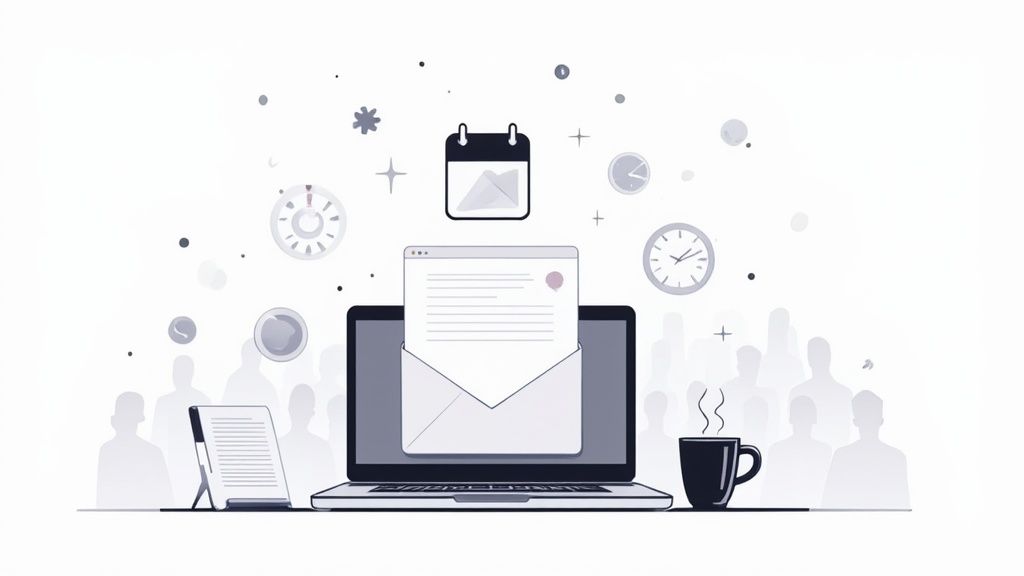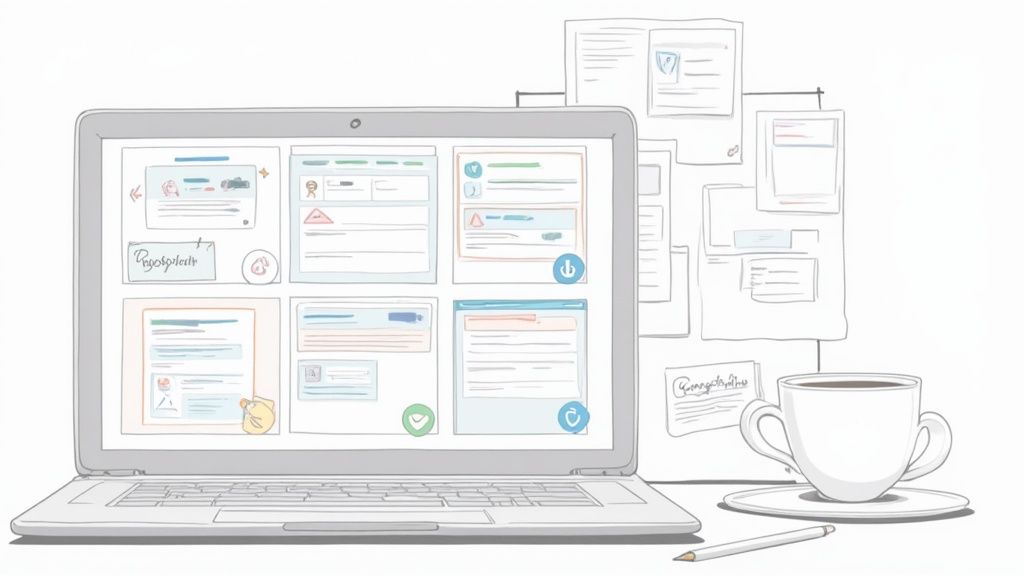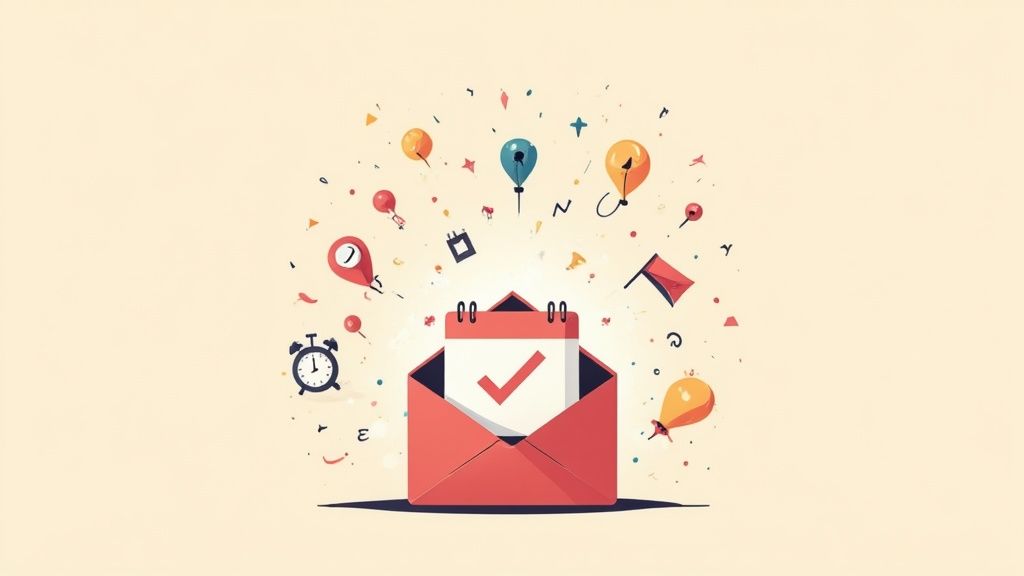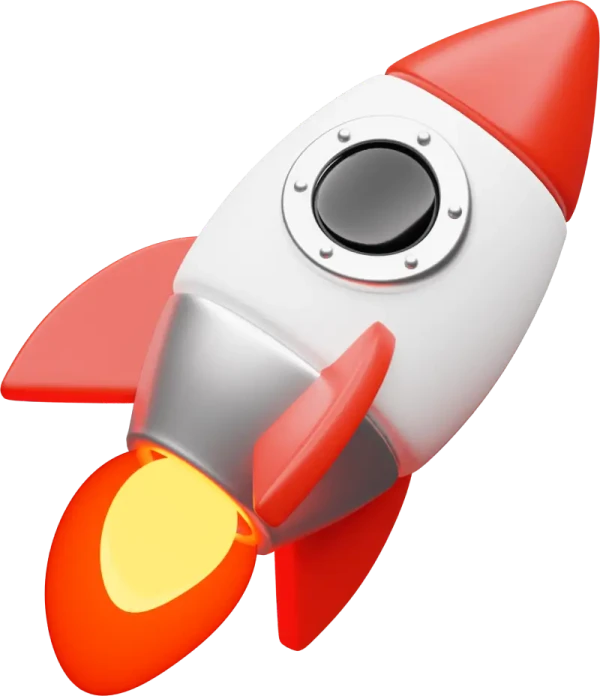A well-crafted reminder email for your event isn't just a simple notification. It's your secret weapon for turning a "maybe" registration into a guaranteed attendee. It's how you cut through a crowded inbox to fight no-shows, build buzz, and remind people exactly why they signed up in the first place.
Why Your Event Reminder Email Is Your Most Crucial Tool
Let's be objective: getting someone to register is only half the job. We all live in a world of endless notifications and competing priorities. Even the most genuinely interested person can forget about an event they signed up for weeks ago. This is exactly where a smart reminder email strategy becomes essential.
As the Social Media Manager for Add to Calendar PRO, I’ve seen time and again that a thoughtful reminder sequence keeps your event top-of-mind. It's not just about a quick "hey, remember this?" - it's about pulling attendees back in and reigniting the excitement they felt when they first clicked "register."
Turning Registrants Into Attendees
A single confirmation email just doesn't cut it anymore. People's schedules are packed, and without a timely nudge, your event can easily get lost in the shuffle. A great reminder email does several vital things all at once:
- It actively combats no-shows. A simple reminder is a direct intervention that can dramatically reduce your drop-off rate.
- It builds anticipation. Use this space to share exciting updates, like a sneak peek at the agenda or a spotlight on a keynote speaker.
- It reinforces value. Gently remind them why they signed up and what they'll miss if they don't show.
- It provides key logistics. This is your chance to make sure they have the correct date, time, and access link right when they're looking for it.
This whole process transforms a basic notification into a valuable piece of content that has a direct, positive impact on your attendance numbers. If you want to go deeper, we have a complete guide on email marketing for events that can help you dial in your overall strategy.
A common mistake is treating reminders like a chore. Don't. See them as a mini-marketing campaign for an audience that’s already bought in. Every single email is another chance to resell the experience.
The Power of a Strategic Sequence
The impact of a good reminder email isn't just a gut feeling; it's backed by data. For instance, a major tech conference discovered that switching from a single, generic message to a carefully timed series of reminders slashed their no-show rate. After implementing their new strategy, they saw a 30% reduction in no-shows. That's a significant win.
Ultimately, a strong reminder strategy is about respecting your attendees' busy lives while making sure your event gets the attention it deserves. It’s your most reliable tool for making sure the audience you worked so hard to attract actually shows up.
Anatomy of an Unforgettable Reminder Email
A great event reminder does more than just state the facts. It’s a strategic touchpoint designed to pull your audience back in, remind them of the value you're offering, and make it ridiculously easy for them to show up. Let's pull back the curtain on the components that transform a basic notification into an attendance-driving machine.
These emails work. The average click-through rate (CTR) for an event email usually hovers between 2.1% and 3%. But top-tier event creators who really nail their reminder strategy have seen CTRs blast past 11%. That shows how much power is hiding in a well-timed, well-written message. You can get a closer look at these event email benchmarks and see what's possible for yourself.
Starting with a Compelling Subject Line
Think of your subject line as the velvet rope at an exclusive event. If it doesn't entice people, nobody's getting in. Your goal should be a mix of clarity, a little urgency, and a clear benefit.
Simple, direct lines often win. Think "Reminder: The Event Name is Tomorrow!" or "Your Access Link for Webinar Name". Adding personalization, like the attendee's first name, is another easy win. It instantly makes the email feel like it was sent just for them, not to a faceless list.
The Core Components of Your Email Body
Once they've opened it, don't make them hunt for information. Your job is to deliver the need-to-know details quickly and cleanly. Forget long, winding paragraphs.
Here’s the absolute must-have checklist for every reminder email:
- Event Title: Put the full, official name of the event right at the top. No confusion.
- Date and Time: This is non-negotiable. Always include the full date and time, and be sure to specify the time zone (e.g., 2:00 PM EST / 11:00 AM PST). This is especially critical for virtual events.
- Location or Access Link: For an in-person event, give them the full address and a link to a map. If it's virtual, the join link should be a big, bold, can't-miss button.
- A Brief Value Reminder: Just one quick sentence to jog their memory about why they signed up in the first place. Something like, "Get ready to master the latest SEO trends" or "We're excited to help you connect with industry leaders."
This scannable format means your attendees find what they need in seconds. Less friction, less frustration, more attendance.
The Most Important Call-to-Action
Beyond just informing, your real mission is to lock in their commitment. And there's one single, powerful call-to-action (CTA) that does this better than anything else.
The ultimate goal of any reminder email is to get your event out of the inbox and onto the attendee's personal calendar. This simple action transforms their passive intent into a scheduled appointment.
This is exactly where an "Add to Calendar" button becomes your best friend. The screenshot below shows how our service, Add to Calendar PRO, lets you create and customize these buttons with zero hassle.
When you include a button like this, you eliminate all the work for the attendee. With one click, they can drop the event - with all its details - right onto their Google, Outlook, or Apple calendar. It’s a tiny step for them that makes a huge difference in whether they actually show up.
Getting Your Reminder Timing and Cadence Just Right
Sending a reminder email for an event is a delicate dance. Send it too early, and it gets lost in the noise of a crowded inbox. Send it too late, and your attendees have already made other plans. Nailing the timing and frequency - your cadence - is what turns a simple reminder into a powerful tool for driving attendance.
There’s no magic, one-size-fits-all schedule. The right cadence hinges entirely on the nature of your event. A multi-day conference needs a much longer runway than a quick one-hour webinar. You wouldn't start packing for a weekend trip a month in advance, but you also wouldn't pack for an international flight an hour before leaving. The same logic applies here.
Think of your reminders as a way to build momentum. Each email is a touchpoint that keeps your event top of mind.
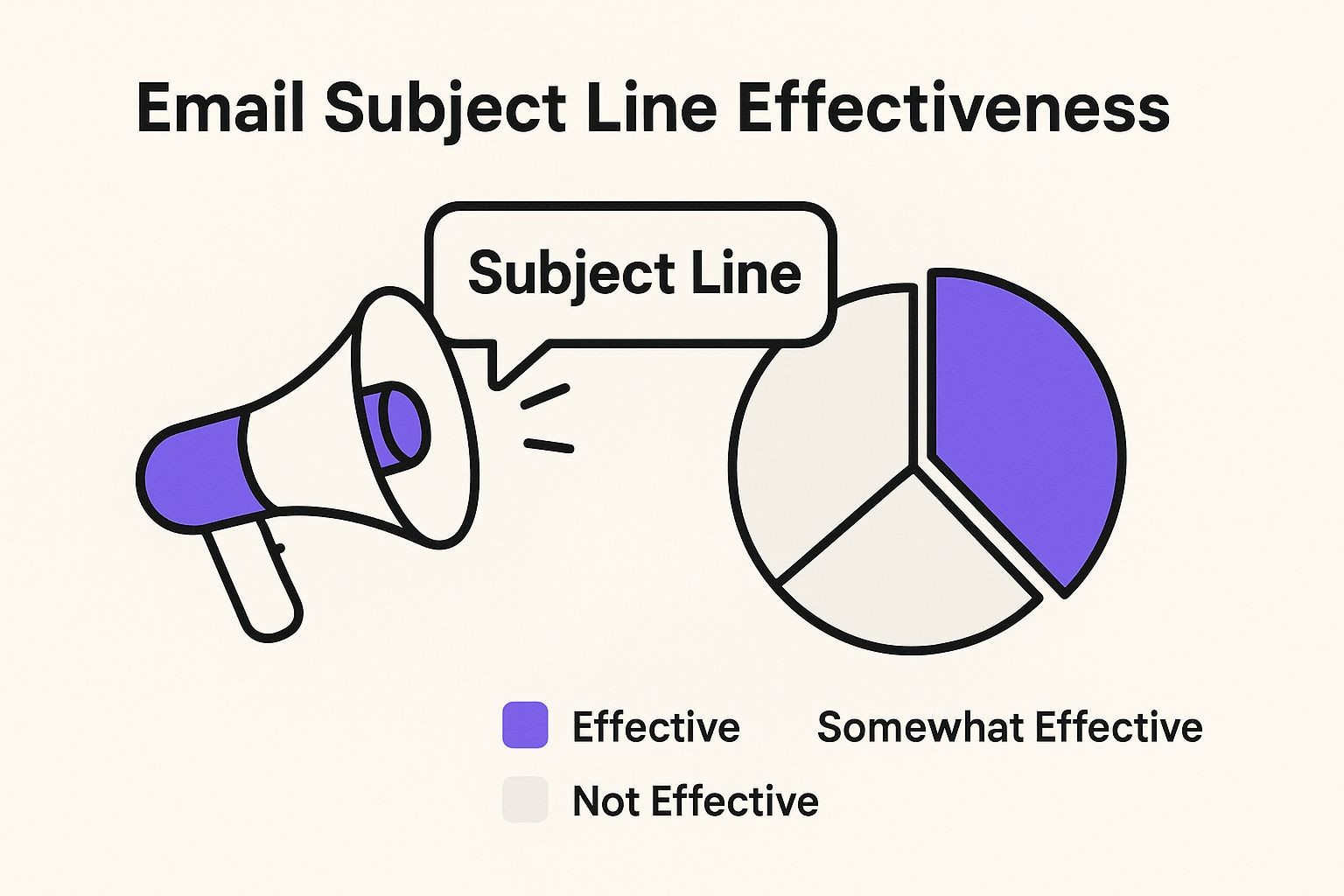
Strategic timing turns a simple email into a megaphone for your event, making sure your message is heard loud and clear when it matters most.
Different Events, Different Cadences
To build a schedule that actually works, you have to think about what kind of event you're hosting. The ideal timing for a webinar is completely different from what you'd need for a big in-person conference. For example, webinars usually see great results with reminders sent one week, one day, and one hour beforehand. In-person events, on the other hand, often need a longer lead time - think reminders sent two weeks out, three days prior, and on the morning of the event.
For hybrid events, you need a smart combination of both approaches to cater to your in-person and virtual attendees. If you want to dig deeper into the data behind this, there are some great expert insights on event email timing that break it down further.
This tailored approach respects the different levels of commitment and planning your attendees need to make for each type of gathering.
One of the biggest mistakes we see is sending the exact same reminder sequence to everyone. You need to segment your audience. Early-bird registrants might appreciate a longer, more spaced-out cadence, while last-minute sign-ups need a more condensed and urgent sequence to get them over the line.
A Practical Schedule to Get You Started
So, what does this look like in practice? To give you a clear, adaptable framework, here's a table outlining some reliable starting points for your reminder schedules. Don’t treat these as rigid rules, but as a solid foundation you can build on.
Recommended Reminder Email Cadence by Event Type
This table outlines a strategic timeline for sending reminder emails based on the type of event you are hosting, helping you maximize attendee engagement and reduce no-shows.
| Event Type | First Reminder | Second Reminder | Final Reminder | Day-Of Reminder |
|---|---|---|---|---|
| Virtual Webinar | 1 week before | 24 hours before | Not Applicable | 1 hour before the event starts |
| In-Person Event | 2 weeks before | 3 days before | 1 day before | Morning of the event |
| Hybrid Event | 2 weeks before | 3 days before | 24 hours before | Morning of & 1 hour before start |
| Multi-Day Conf. | 1 month before | 1 week before | 2 days before | Morning of each day |
By adapting your schedule to the specific format of your event, you ensure your communication feels genuinely helpful, not spammy. A well-timed reminder respects your attendee's time and significantly boosts the chances they’ll be there when it counts.
Writing Subject Lines That Demand to Be Opened
Let's be real: your perfectly written reminder email is totally useless if no one opens it.
The subject line is the gatekeeper to all your hard work. In a crowded inbox, it has just a few seconds to grab someone's attention. A generic subject line like "Event Reminder" is a one-way ticket to the trash folder, blending into the background noise of a hundred other emails.
The goal isn't just to be clever; it's to be clear and compelling. The best subject lines answer the attendee's unspoken question: "Why should I open this right now?"
Tapping into Proven Formulas
You don't need to reinvent the wheel every single time. Certain formulas just plain work because they’re direct and give immediate value. A great place to start is by A/B testing a few different approaches to see what your specific audience responds to.
Here are a few categories that consistently perform well, with examples you can adapt:
- Urgency-Driven: These create a sense of timeliness and nudge people to act now, not later.
- Examples: "Final reminder: The Webinar Name starts in one hour!" or "Don't miss out: Event Name is tomorrow!"
- Personalized: Simply using an attendee's name can make an email feel more like a personal note and less like a mass broadcast.
- Examples: "Name, are you ready for the big day?" or "Your personal agenda for Conference Name."
- Value-Focused: These highlight a key benefit or a new piece of information, giving them a concrete reason to click.
- Examples: "The final speaker list for Event Name is here!" or "Exclusive pre-event content inside."
For a deeper dive, you can explore some great event reminder email examples and see how different subject lines pair with various message types. It's a great way to get solid ideas for your own campaigns.
A common mistake is saving all the good stuff for the email body. Your subject line needs to carry some of that weight. Instead of "Reminder for our event," try "Your access link for tomorrow's SEO workshop." The second one is immediately useful.
Keeping It Clear and Concise
While a little creativity is great, clarity is king.
Your subject line has to be understood at a glance, especially on mobile devices where you have even less screen real estate. A good rule of thumb is to aim for subject lines under 50 characters for the best visibility.
Avoid vague language or clickbait that doesn't deliver on its promise. Building trust is a huge part of event marketing, and that starts with the very first words your attendees read. Combine a clear message with a touch of urgency or personalization, and you'll dramatically increase the chances that your reminder gets opened, read, and acted upon.
How Add to Calendar Buttons Secure Attendance
Let's talk about the single most powerful tool you can put in an event reminder email: the ‘Add to Calendar’ button. This isn't just a simple link; it's what turns a passive reminder into a firm commitment. Think of it as the digital equivalent of a handshake, solidifying your registrant's plan to be there.
The whole point is to get your event out of their crowded inbox and onto their personal calendar. Once it lands there, it becomes a real, scheduled part of their day - complete with its own native notifications from Google Calendar, Outlook, or Apple Calendar. That one click bridges the huge gap between "I'm interested" and "I'll be there."
Turning Intent into a Scheduled Commitment
When someone registers for your event, they've shown intent. That's great, but life gets busy, and that initial excitement can easily fizzle out. An ‘Add to Calendar’ button is your best defense against this drop-off.
Why does it work so well? It’s all about eliminating friction. Instead of making someone manually create a calendar entry - a task that's easy to put off and then forget - you do all the heavy lifting for them. With a single click, they can pull all the crucial event details right into their calendar. It’s a simple action that can boost attendance by up to 40% by cutting down on no-shows.
Making It Effortless for Attendees
Here’s how our service makes this process foolproof. We ensure that when someone clicks that button, all the essential info is pre-filled and perfectly formatted for whatever calendar app they use.
- Universal Compatibility: It just works, whether they use Google Calendar, Outlook, Apple Calendar, or other major platforms.
- Time Zone Accuracy: The event details automatically adjust to the user's local time zone, which kills one of the most common sources of confusion for virtual events.
- Reduced Human Error: No more typos in the date or a mix-up in the time. The information is transferred perfectly, every time.
The easier you make it for someone to commit, the more likely they are to show up. That’s the simple truth behind the power of an ‘Add to Calendar’ button.
The moment your event lands on someone’s personal calendar, it stops being your marketing message and starts being their personal appointment. This mental shift is what turns a hopeful registrant into a confirmed attendee.
You can also customize the button’s look and the event details it shares to keep everything on-brand. The screenshot below shows just how easy it is to create and style your button right from our dashboard.
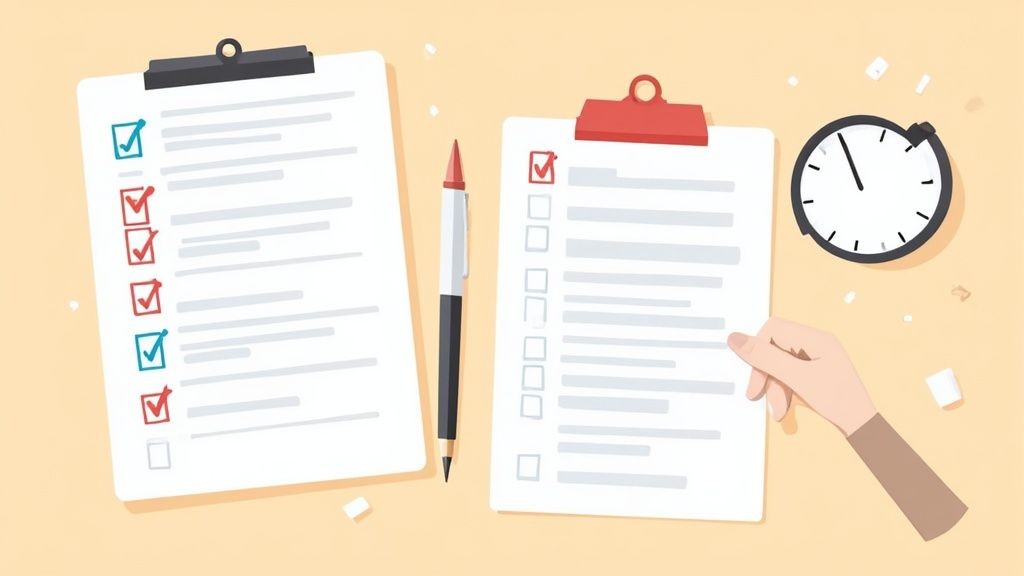
This level of control means even a small, functional element like this feels like a natural part of your brand. To see everything you can do, you can learn more about our Add to Calendar button features. By putting this simple, powerful tool in every reminder email, you’re not just hoping for better attendance - you’re actively securing it.
Common Questions About Event Reminder Emails
Even with a rock-solid plan, a few questions always seem to pop up when you're putting together reminder emails. Let's tackle some of the most common ones we hear from event organizers.
How Many Reminder Emails Should I Actually Send?
For most events, three is the magic number. A great cadence to start with is sending one out a week before, another two or three days before, and a final one on the day of the event. This approach keeps your event top-of-mind without spamming people's inboxes.
That day-of email is especially crucial for virtual events - think a "starting in one hour" notification. The pro-tip here is to add something new and valuable in each send. Don't just repeat yourself. Share a speaker quote, highlight a specific agenda item, or offer a quick networking tip. Give them a reason to open each one.
What's the Single Most Important Part of a Reminder Email?
If you had to pick just one, it’s a tie between two things that work together: the subject line and the call-to-action (CTA).
Your subject line does the heavy lifting to get the email opened. No open, no attendee. But the CTA is what seals the deal. A clear, impossible-to-miss "Add to Calendar" button is the action that turns a passive registrant into someone who has actually blocked off the time. That one little click dramatically slashes your no-show rate.
Should I Bother Personalizing My Reminders?
Yes, and not just by using [First Name]. Real personalization means sending the right message to the right people at the right time. It’s about making your emails feel indispensable, not intrusive.
Don't just blast the same generic reminder to your entire list. A little segmentation goes a surprisingly long way. For instance, send an exclusive "sneak peek" to your early-bird ticket holders. Or, if you have different tracks, highlight the sessions most relevant to specific attendee groups.
This kind of targeted approach shows you get your audience and respect their time. In return, they're far more likely to engage with your messages and show up ready for your event.
Ready to make sure every single registrant becomes an attendee? Add to Calendar PRO makes it incredibly simple to drop powerful, on-brand "Add to Calendar" buttons into your emails and website. You get the commitment with a single click. Explore all the features and start your free trial today.
